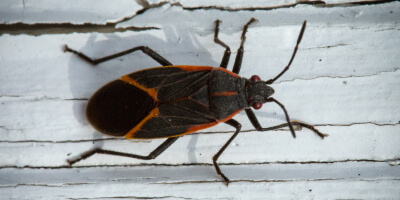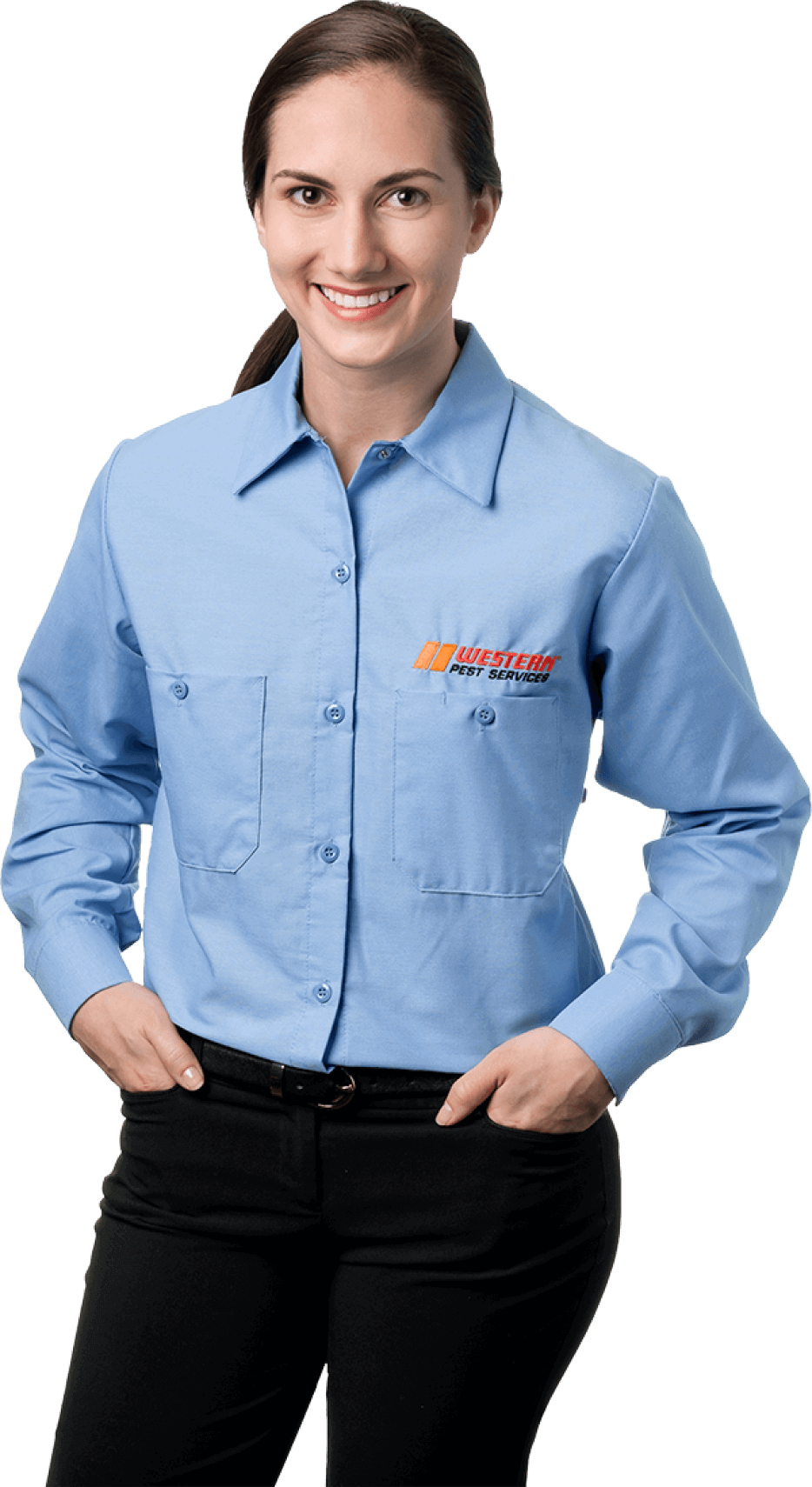Boxelder Bug Facts & Information
Everything you need to know about boxelder bugs
WHAT DO boxelder bugs LOOK LIKE

Boxelder bugs are black with reddish or orange markings on their back. Adult boxelder bugs have a body shape that is a somewhat flattened and elongated oval and is about half an inch long. They have six legs and two antennae that are typically half of their body length. Nymphs look similar to adults but lack wings and are bright red in color. Their red color can get them confused with the spotted lanternfly but they are nothing alike.
Where do boxelder bugs live
Boxelder bugs get their common name from the fact that they are often found on and around boxelder trees. This species is native throughout New York, New Jersey, Pennsylvania, Delaware, and Connecticut – basically wherever boxelder trees are found. Boxelder bugs are primarily a nuisance pest as they enter structures, including homes, sheds and garages to overwinter.
In autumn, boxelder bugs become gregarious and congregate on the south side of rocks, trees and buildings where the sun hits. After large masses gather, they migrate to nearby buildings or homes to overwinter. These pests tend to hide in small cracks and crevices in walls to insulate themselves from the cold winter temperatures. In late March to early April, adults leave their overwintering sites to return to their host trees for the warmer months.
In autumn, boxelder bugs become gregarious and congregate on the south side of rocks, trees and buildings where the sun hits. After large masses gather, they migrate to nearby buildings or homes to overwinter. These pests tend to hide in small cracks and crevices in walls to insulate themselves from the cold winter temperatures. In late March to early April, adults leave their overwintering sites to return to their host trees for the warmer months.
How did I get boxelder bugs
Since boxelder bugs are usually inside looking for a place to wait out the colder months, it’s nothing you’re doing that’s attracting them other than having warmth and shelter. They can easily slip in through a crack or crevice or a screen that hasn’t been replaced. They can even sneak in on deliveries! If you have a lot of cracks and crevices or screens that have tears, then you’ll have boxelder bugs – and stink bugs and flies and moths and just about all other pests that make their way inside whether on purpose or by mistake.
what Problems do Boxelder Bugs cause
Inside, boxelder bugs are primarily a nuisance pest, however their fecal material can cause a red stain on curtains, drapes, clothing, etc. When crushed or handled roughly, boxelder bugs can also produce a strong, disagreeable odor. Boxelder bugs generally become a problem when they invade homes, sheds, and garages in the fall and when they emerge in the spring. Like many overwintering pests, homeowners may see evidence of these bugs as the winter ends and they leave their overwintering site to go back outdoors.
The females lay clusters of straw-yellow eggs on stones, eaves, grass, shrubs, and trees – especially in the bark crevices of boxelder trees (hence their name). The eggs turn red as the embryos develop and hatch about two weeks later. The nymphs feed on fallen boxelder seeds and later on new leaves. There can be two generations per year in warmer regions.
In the fall, boxelder bugs become gregarious and congregate on the south side of rocks, trees, and buildings where the sun hits. After large masses gather, they migrate to nearby buildings or homes to overwinter. These pests tend to hide in small cracks and crevices in walls to insulate themselves from the cold winter temperatures.
Boxelder bugs are not known to bite, but their piercing-sucking mouthparts can occasionally puncture skin, causing a slight irritation and producing a red spot similar to a mosquito bite. When crushed or handled roughly, boxelder bugs may leave a reddish orange stain from their fecal material that can result in discoloration of curtains, drapes, clothing, etc.
The females lay clusters of straw-yellow eggs on stones, eaves, grass, shrubs, and trees – especially in the bark crevices of boxelder trees (hence their name). The eggs turn red as the embryos develop and hatch about two weeks later. The nymphs feed on fallen boxelder seeds and later on new leaves. There can be two generations per year in warmer regions.
In the fall, boxelder bugs become gregarious and congregate on the south side of rocks, trees, and buildings where the sun hits. After large masses gather, they migrate to nearby buildings or homes to overwinter. These pests tend to hide in small cracks and crevices in walls to insulate themselves from the cold winter temperatures.
Boxelder bugs are not known to bite, but their piercing-sucking mouthparts can occasionally puncture skin, causing a slight irritation and producing a red spot similar to a mosquito bite. When crushed or handled roughly, boxelder bugs may leave a reddish orange stain from their fecal material that can result in discoloration of curtains, drapes, clothing, etc.
How can I prevent boxelder bugs
In order to prevent boxelder bugs from invading homes, repair holes in window and door screens, seal cracks and crevices with a good quality silicone or silicone-latex caulk, and install door sweeps to all exterior entrances. These can all be done by a pest control professional that is proficient in exclusion work. All of them should be!
When getting rid of boxelder bugs that have already entered your home or business, no attempt should be made to kill them in wall voids because dead insect bodies can attract other bugs that like to feed on their carcasses like larder beetles, carpet beetles, etc. Experts recommend waiting until summer when all live overwintering adults are out of the wall voids. To provide temporary relief during this time, consider using a vacuum cleaner to get rid of the boxelder bugs. The bag should be removed to prevent the bugs from escaping. Then, seal up any entryways into the living space – window pulleys, window and door frames, baseboards, etc. – to prevent a future infestation. For electrical outlets, switch boxes, heating ducts and return air vents, remove the cover plate, seal, and replace. For light fixtures and ceiling fans, remove the fixture to its base plate, seal, and replace.
When getting rid of boxelder bugs that have already entered your home or business, no attempt should be made to kill them in wall voids because dead insect bodies can attract other bugs that like to feed on their carcasses like larder beetles, carpet beetles, etc. Experts recommend waiting until summer when all live overwintering adults are out of the wall voids. To provide temporary relief during this time, consider using a vacuum cleaner to get rid of the boxelder bugs. The bag should be removed to prevent the bugs from escaping. Then, seal up any entryways into the living space – window pulleys, window and door frames, baseboards, etc. – to prevent a future infestation. For electrical outlets, switch boxes, heating ducts and return air vents, remove the cover plate, seal, and replace. For light fixtures and ceiling fans, remove the fixture to its base plate, seal, and replace.
WHY WESTERN for Boxelder Bug control
We’re passionate about controlling boxelder bugs in your home or business because we live and work here – it’s our neighborhood, too. With our almost 100 years of experience keeping homes and businesses in Connecticut, Delaware, New Jersey, New York, and Pennsylvania safe from pests, Western has the experience you can trust.
100% Satisfaction Guarantee
24-Hour Guaranteed Response
Board Certified Entomologists
Consider boxelder bugs controlled.
GET MY QUOTE
